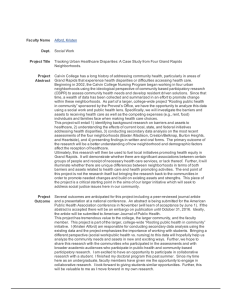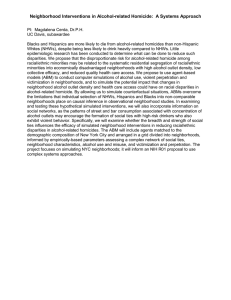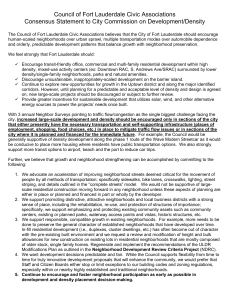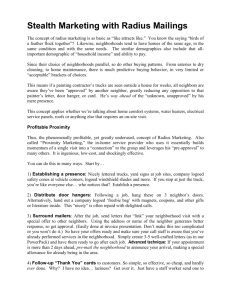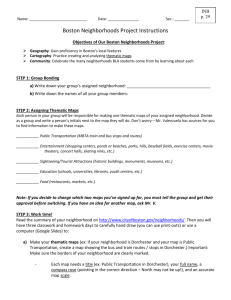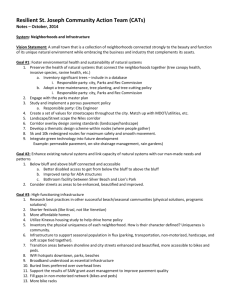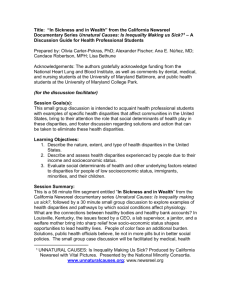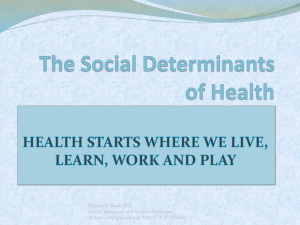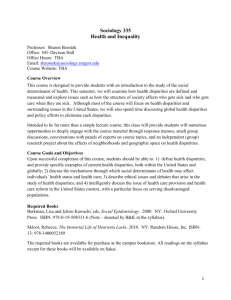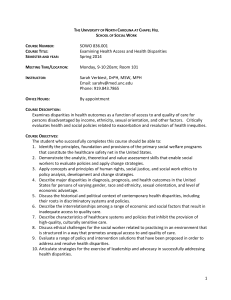“Place Matters”
advertisement
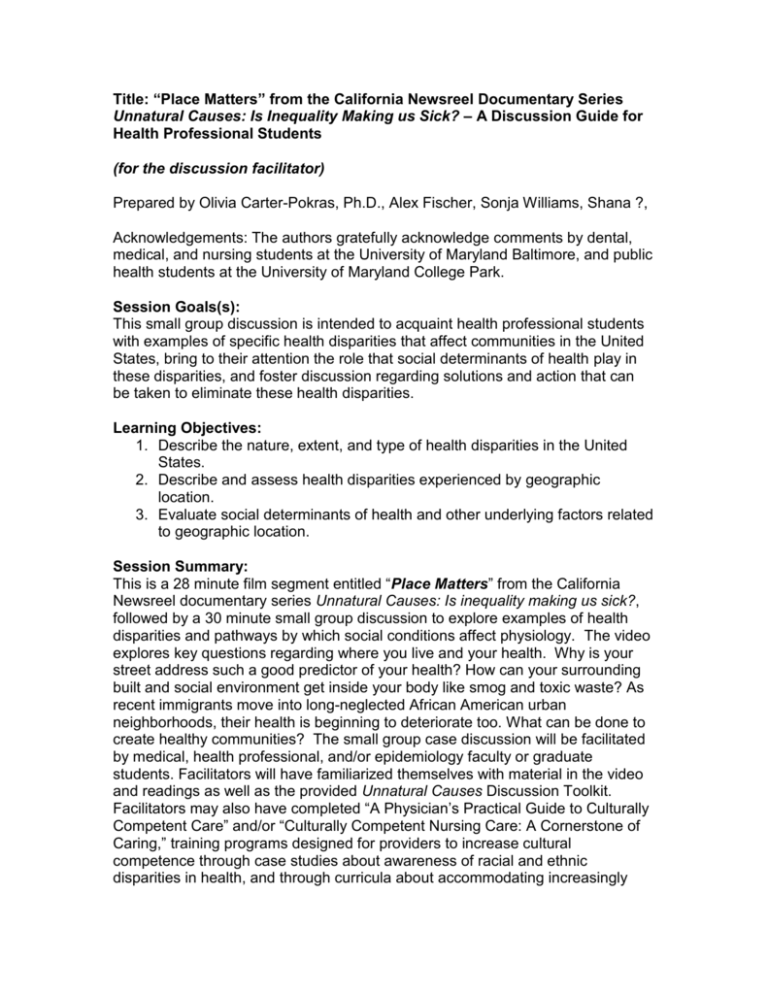
Title: “Place Matters” from the California Newsreel Documentary Series Unnatural Causes: Is Inequality Making us Sick? – A Discussion Guide for Health Professional Students (for the discussion facilitator) Prepared by Olivia Carter-Pokras, Ph.D., Alex Fischer, Sonja Williams, Shana ?, Acknowledgements: The authors gratefully acknowledge comments by dental, medical, and nursing students at the University of Maryland Baltimore, and public health students at the University of Maryland College Park. Session Goals(s): This small group discussion is intended to acquaint health professional students with examples of specific health disparities that affect communities in the United States, bring to their attention the role that social determinants of health play in these disparities, and foster discussion regarding solutions and action that can be taken to eliminate these health disparities. Learning Objectives: 1. Describe the nature, extent, and type of health disparities in the United States. 2. Describe and assess health disparities experienced by geographic location. 3. Evaluate social determinants of health and other underlying factors related to geographic location. Session Summary: This is a 28 minute film segment entitled “Place Matters” from the California Newsreel documentary series Unnatural Causes: Is inequality making us sick?, followed by a 30 minute small group discussion to explore examples of health disparities and pathways by which social conditions affect physiology. The video explores key questions regarding where you live and your health. Why is your street address such a good predictor of your health? How can your surrounding built and social environment get inside your body like smog and toxic waste? As recent immigrants move into long-neglected African American urban neighborhoods, their health is beginning to deteriorate too. What can be done to create healthy communities? The small group case discussion will be facilitated by medical, health professional, and/or epidemiology faculty or graduate students. Facilitators will have familiarized themselves with material in the video and readings as well as the provided Unnatural Causes Discussion Toolkit. Facilitators may also have completed “A Physician’s Practical Guide to Culturally Competent Care” and/or “Culturally Competent Nursing Care: A Cornerstone of Caring,” training programs designed for providers to increase cultural competence through case studies about awareness of racial and ethnic disparities in health, and through curricula about accommodating increasingly diverse patient populations and improving the quality of health care services given to diverse populations (available at: http://www.thinkculturalhealth.org). Students will be provided the background readings at least one week in advance of discussion. Readings: Discussion Questions: 1. Why is our health so heavily dependent on where we live? Numerous neighborhood-dependent determinants of health make the place where we live a critical health determinant, and include chemical exposures, social factors such as interaction with neighbors, violence and crime, access to healthy food, and safe places to exercise 2. What is the “poverty tax” and how does it affect poorer neighborhoods? The video talks about how bargains are hard to come by without negative consequences, such as fast food. The poverty tax represents the phenomenon showing that cars, groceries and check cashing among other things, cost more in poorer areas. As a result, it makes access to such services even more difficult for less affluent residents, and only widens the gap between poorer and wealthier neighborhoods. 3. Why is there such a gap between the quality of different neighborhoods? Such gaps arise as a result of policies or a lack of policies that create large inequalities in resources. A powerful trend takes places, once a neighborhood starts going down. Businesses do not want to come in. Funding for schools lacks, and families do not want to move in, rather they want to escape the neighborhood, yet those who do not have the means to leave are left behind. 4. The video gives the example of the boom town of Richmond 60 years ago. What happened after the war effort, and what did this mean for residents and housing, especially along racial lines? After the war effort, the number of jobs available in Richmond dropped dramatically. To escape the declining industry, those who could move out did just that; however, only white families could get the new government backed mortgages to buy homes in the new suburbs. Racially restricted federal housing initiatives also prevented non-whites from obtaining loans. 5. What effect can economic insecurity have on health? Worry about economic insecurity can be a persistent stressor that constantly weighs on the body. With such chronic stress, the body produces cortisol and adrenaline. But too much of these hormones can result in arterial plaque build-up, increased blood pressure, a decreased immune system, and thus increasing risk of almost all chronic diseases including heart disease. 6. How does our given neighborhood affect our hopefulness for success in the future, and how does this translate into health? Having the resources we need to succeed in our neighborhoods, such as quality education, safety, and a sense of community belonging and support, are tremendous factors in determining our hopefulness for the future. Many of the children interviewed from disadvantaged neighborhood said that they did not expect to live past the age of 20. The lack of hopefulness is also a chronic stressor that can have a negative impact on health. If we constantly have to worry about whether we will have certain opportunities, or whether our children will have these opportunities, it is added stress that will weigh on the body. 7. Did the video show any examples of innovative initiatives to improve the healthiness and liveability of neighborhoods? The YES program provides youth empowerment strategies, and works to give them the knowledge that they can control their lives, and be proactive to make changes to better the community. The initiative to rebuild the High Point community aimed to give the power to its residents, to form a mixed income, integrated community, provided with the necessary educational and social resources, as well as the health resources such as special accommodations for those with asthma problems. 8. How can we turn an “unhealthy” neighborhood into one that is “healthy”? Individuals and market-driven industry need to be educated that the neighborhood in which we live has a great effect on our health. We must work to improve the social, physical, and economic environoment of the places we live, by improving housing and education, decreasing violence, and improving health policy.
